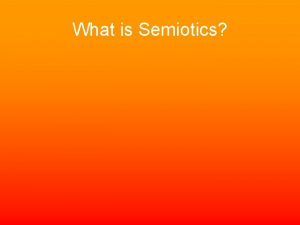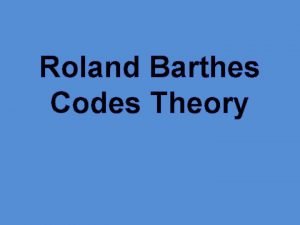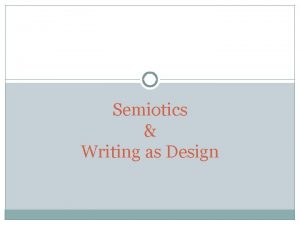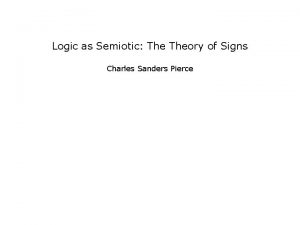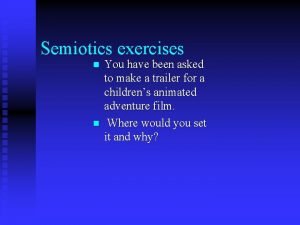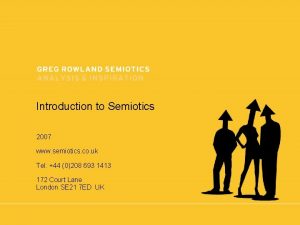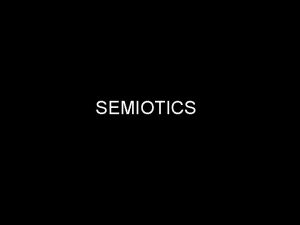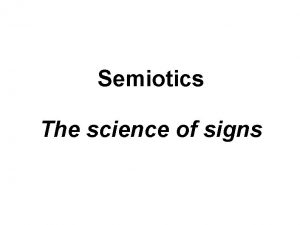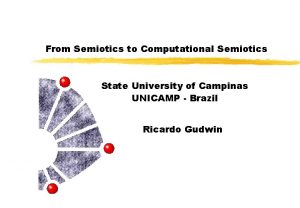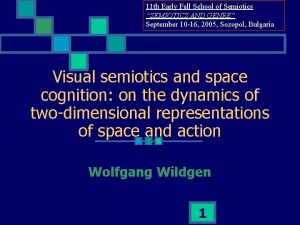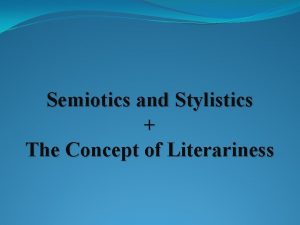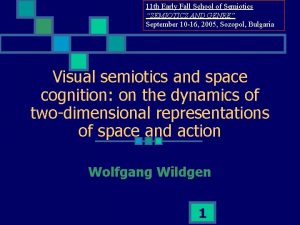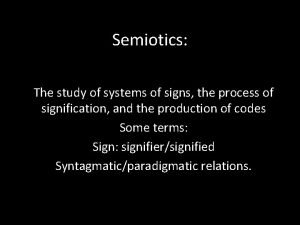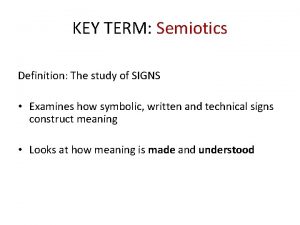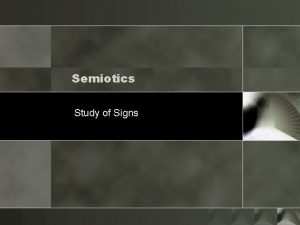Semiotics Writing as Design Semiotics Semiotics the study


![Semiotics Charles Pierce (1839 – 1914) [purse] Semiotics is a process, that involves a Semiotics Charles Pierce (1839 – 1914) [purse] Semiotics is a process, that involves a](https://slidetodoc.com/presentation_image_h/96b3396914d511f3dee7614986cf4e7f/image-3.jpg)












































- Slides: 47

Semiotics & Writing as Design

Semiotics �Semiotics – the study of signs both in the way they come to have meaning and their mode of transfer. �Some key tenets of semiotics Signs are arbitrary – sign (e. g. language) and meaning is a socially agreed upon contract, and the meaning applied to words/signs is not static. Signs are not the thing – tree ≠ the actual tree, it only represents the tree. This was a big deal in 1906. Signs rely on transmission codes that are themselves layers of further semiotic relationships.
![Semiotics Charles Pierce 1839 1914 purse Semiotics is a process that involves a Semiotics Charles Pierce (1839 – 1914) [purse] Semiotics is a process, that involves a](https://slidetodoc.com/presentation_image_h/96b3396914d511f3dee7614986cf4e7f/image-3.jpg)
Semiotics Charles Pierce (1839 – 1914) [purse] Semiotics is a process, that involves a sign, its sense, and the actual object Ferdinand de Saussure (1857 – 1913) [so-sewer] Semiotics refers is the relationship between the signifier (the word or image) and the signified (what it represents in the person’s mind) René Magritte La trahison des images

Part 1: Codes

Codes • Signs make sense through codes. • Codes are interpretation systems that are created and interpreted through culture. • Codes interrelate with other codes and require understanding three domains: • • • The world (social knowledge) The medium and the genre (textual knowledge) The relationship between knowledge of the world and knowledge of a medium and genre (modality judgments)

Broadcast and Narrowcast Codes • Broadcast or “restricted” codes are the codes shared with a large audience and rely on redundancy and repetitiveness for meaning. Examples – Avril Lavigne, Mc. Donalds, NY Times, Lost • Narrowcast or “elaborated” codes are shared with a smaller, more specialized audience. Examples – Charlie Parker, Bistro Vendome, Written Communication, Attack of the Show

Broadcast and Narrowcast Codes • Broadcast codes, according to Umberto Eco, strongly encourage how the text/sign should be interpreted (The Role of the Reader, 1981) because they are restricted in their variety and uniqueness. • Narrowcast codes have very little redundancy, produce unpredictability, and allow greater elaboration, so they don’t necessarily require a particular interpretation, although interpretations and assumptions from “outsiders” do occur. �Of course, these distinctions are used to create dichotomies between low art and high art, but as we saw in the examples, such distinctions don’t necessarily have to exist.

Types of Codes �Within any culture, there is always one dominant code which is seen as ‘natural’ and/or invisible �All codes, narrowcast and broadcast, dominant and non-dominant are also comprised of many sub-codes. �Sub-codes: • • • Social codes: verbal language, bodily codes, commodity codes, behavioral codes Textual Codes: scientific codes, aesthetic codes, rhetorical and stylistic codes, mass media codes Interpretative Codes: ideological codes, perceptual codes, realism codes

Sub-Code 1: Social Codes �Social codes are largely influenced through verbal language, but our bodies, the things we wear, the objects we use, and the way we behave also determine the structure and maintenance of social realities. verbal language bodily codes commodity codes behavioral codes

Social Codes for Touching in Japan and the USA

The Social Construction of Identity �To a large degree the many different social codes determine how we think of society and, by contrast, ourselves. �Because there are so many different social codes which vary with context, various competing ‘selves’ are created. In other words, the ‘self’ is never constant but changes with the various codes it must operate in. In a way, codes create and position the ‘self’ within society, but this creation and positioning changes with society and is always contested. Think of how ethos is not “who you are” as much as it is the persona you create for an audience. Excerpt, This American Life, “My Reputation”

Sub-Code 2: Textual Codes • Because codes are shared interpretive frameworks, they can simplify complex phenomenon in order to communicate experience and ideas • • scientific codes aesthetic codes rhetorical and stylistic codes mass media codes • We routinely judge a book by its title (or cover). “Displaced peoples inhabiting a quasi-paranormal land mass: Seven character studies” “Lord of the Flies for the Next Millennium” “The Dysfunctional Castaways” “Hurley’s Island” “Lost”

Textual Codes • Genres • • Works written in measured stanzas we claim and read as poems. IMRAD format we think of science • Symbols • • Numbers are associated with facts and hard evidence Words are associated with rationality • Media • • Typed words are associated with publication and objectivity as well as prestige Hand-written words are associated with the personal

Sub-code 3: Interpretative Codes �Reading and seeing is also a process of encoding. We see signs and symbols through a lens that transforms the sign. Ideological codes Perceptual codes

Ideological Codes • Ideological codes are conveyed or learned by social and textual institutions • Our interpretive lens ranges from the consciously taught “–isms” to the dominant, hegemonic discourses • These ideological codes are the lenses we use for coding and decoding texts (signs, symbols, indices, icons, etc. )

Perceptual Codes �We “learn” how to perceive by the repetition of visual codes that a culture perpetuates. �However, cultural influences only play a part. We also tend to favor the simplest and easiest to understand perceptions because they are cognitively familiar to us. This is called prägnanz – we tend to want order, simplicity and symmetry.

Principle of Proximity �What do you notice in this diagram of dots? features which are close together are associated.

Principle of Proximity (cont. ) �What do you notice in this diagram? features which are close together are associated.

Principle of Similarity �What do you notice in this diagram? features which are similar are associated.

Principle of Good Continuity �What do you notice in this diagram? contours based on smooth continuity are preferred to abrupt changes of direction

Principle of Closure �What do you notice in this diagram? interpretations which produce 'closed' rather than 'open' figures are favored.

Principle of Smallness �What do you notice in this diagram? smaller areas tend to be seen as figures against a larger background

Principle of Symmetry �What do you notice in this diagram? Symmetrical areas tend to be seen as figures against asymmetrical backgrounds

Principle of Surroundedness �What do you notice in this diagram? areas which can be seen as surrounded by others tend to be perceived as figures

Codes of Realism • “All representations are systems of signs: they signify rather than ‘represent’, and they do so with primary reference to codes rather than ‘reality’ (Chandler 161). • In other words, realistic texts are ‘realistic’ only because they conform to a dominant code and not to a representation of ‘reality. ’

Monet

Monet

Photographs � Photography and film look real because they reflect our dominant codes of perception —our dominant ways of ‘seeing. ’ � Think of mechanical aspects of photography like flattening, perspective, proportion and color or � Aspects of human control like framing, focus, angle, lighting, choice of subject, composition, etc.

Photographs Interpretive codes are part of both the producer and the consumer. In other words, the lens of the person taking an image, “real” or not, is influence by his/her own set of codes, just as the “seer” applies his/her own lens.

Film and Television • As agents in the signifying process, viewers and producers construct a reality on the screen based on familiar codes so that the finished product displays continuity with the physical world.

Principle of eyeline match • Watch the following two slides, and think about what they signify…



Juxtaposition (eyeline match) The two shots in succession signify that the character in slide 1 is looking at the object in slide 2—when in fact, we have no way of knowing what the character in slide 1 is really looking at, but we believe he is looking at the church in slide 2

Establishing Shot �We start with a long shot to “set the scene” and then we can focus on the details because we understand the setting.

Motivated Cuts �Because this code foregrounds the narrative, it employs what are called motivated cuts: changes of view or scene occur only when the action requires it and the viewer expects it. When cuts from one distance and/or angle to another are made, they normally match on action.

Codes in practice • Because the most prevalent code is language, we often don’t realize that we are interpreting the code, nor the contextualization of the code. • For example, what does the following sentence mean? “Students must take 1133” • We instantly recognize what this sentence means, because of context and relationship of the codes (social, textual, interpretative) Which students? Where? What should they do with it once they take it?

Codes in Practice • Visual features used in your text can’t be just inserted as they might violate textual, social or perceptual codes. • Visuals become as rhetorically important as the text you use to make an argument. What message does this send?

Codes in Practice �What about these two banner advertisements?

Part 2: Media

Media �Media is the stuff the sign is written on. �Each medium has particular codes associated with it. The computer screen allows text to be ephemeral and changeable. Paper represents permanence. Computer screen, especially the Internet is perceived with some skepticism since “anybody” can write on it. �Each medium has affordances and constraints See Table 4. 1 (p. 58) in Sharples

External Representations �Creating texts on multiple media can help you understand the affordances and constraints of certain media. Try writing on a typewriter, in cursive, or in hypertext. �External representations set on paper allow sustained and reference-able arguments. That is why they have had such a long relationship in academia.

Part 3: Context

Context �Context influences which codes we use, what resources a given audience, purpose, and writer have available, and what media exists. It is helpful to think of context consisting of three related elements Mise-en-scène – a term from movies and theater that means everything in the scene that isn’t the actors or the action. Kairos – rhetorical term #1. The moment in time, or the opportune moment. Exigence – rhetorical term #2. That which is required and available for a given situation.

Writing as Design

The Rhetorical Canon �In each stage of the classical process of argument formation, codes, media, and context apply. �Inventio (Invention) �Dispositio (Arrangement) �Elecutio (Style) �Memoria (Memory) �Pronuntiatio (Delivery) Is it easier to invent (cluster, brainstorm, outline) on paper or the computer? Is it easier to arrange text on a typewriter or a computer? How do you create a memorable document for your audience? Does how a document look influence what it says?

Writing as Design �Consider writing as a process of design, in which you have a problem or question—a primary generator—that instigates a good question. Approach it as a problem that needs to be addressed rather than a something that already exists. �It is helpful to consider Lawson’s Elements of Design (ctd. in Sharples, p. 60): 1. 2. 3. 4. 5. 6. 7. Design problems are open-ended and cannot be fully specified The design process is endless There is no infallibly correct process of design The process involves finding as well as solving problems Design inevitably involves subjective value judgment Design is a prescriptive [constructive] activity Designers work in the context of a need for action
 Vcaa visual communication technical drawing specifications
Vcaa visual communication technical drawing specifications Saussure dyadic model
Saussure dyadic model Roland barthes hermeneutic code
Roland barthes hermeneutic code Semiotics myth examples
Semiotics myth examples Which diagram
Which diagram Nonton paw patrol the movie 2021
Nonton paw patrol the movie 2021 Semiotics
Semiotics Semiotics
Semiotics Semiotics exercise
Semiotics exercise Semiotics
Semiotics Semiotics in music
Semiotics in music Greg rowland semiotics
Greg rowland semiotics Hình ảnh bộ gõ cơ thể búng tay
Hình ảnh bộ gõ cơ thể búng tay Frameset trong html5
Frameset trong html5 Bổ thể
Bổ thể Tỉ lệ cơ thể trẻ em
Tỉ lệ cơ thể trẻ em Chó sói
Chó sói Thang điểm glasgow
Thang điểm glasgow Hát lên người ơi
Hát lên người ơi Các môn thể thao bắt đầu bằng tiếng đua
Các môn thể thao bắt đầu bằng tiếng đua Thế nào là hệ số cao nhất
Thế nào là hệ số cao nhất Các châu lục và đại dương trên thế giới
Các châu lục và đại dương trên thế giới Cong thức tính động năng
Cong thức tính động năng Trời xanh đây là của chúng ta thể thơ
Trời xanh đây là của chúng ta thể thơ Cách giải mật thư tọa độ
Cách giải mật thư tọa độ 101012 bằng
101012 bằng Phản ứng thế ankan
Phản ứng thế ankan Các châu lục và đại dương trên thế giới
Các châu lục và đại dương trên thế giới Thơ thất ngôn tứ tuyệt đường luật
Thơ thất ngôn tứ tuyệt đường luật Quá trình desamine hóa có thể tạo ra
Quá trình desamine hóa có thể tạo ra Một số thể thơ truyền thống
Một số thể thơ truyền thống Cái miệng bé xinh thế chỉ nói điều hay thôi
Cái miệng bé xinh thế chỉ nói điều hay thôi Vẽ hình chiếu vuông góc của vật thể sau
Vẽ hình chiếu vuông góc của vật thể sau Thế nào là sự mỏi cơ
Thế nào là sự mỏi cơ đặc điểm cơ thể của người tối cổ
đặc điểm cơ thể của người tối cổ V. c c
V. c c Vẽ hình chiếu đứng bằng cạnh của vật thể
Vẽ hình chiếu đứng bằng cạnh của vật thể Vẽ hình chiếu vuông góc của vật thể sau
Vẽ hình chiếu vuông góc của vật thể sau Thẻ vin
Thẻ vin đại từ thay thế
đại từ thay thế điện thế nghỉ
điện thế nghỉ Tư thế ngồi viết
Tư thế ngồi viết Diễn thế sinh thái là
Diễn thế sinh thái là Dot
Dot Bảng số nguyên tố
Bảng số nguyên tố Tư thế ngồi viết
Tư thế ngồi viết Lời thề hippocrates
Lời thề hippocrates Thiếu nhi thế giới liên hoan
Thiếu nhi thế giới liên hoan

